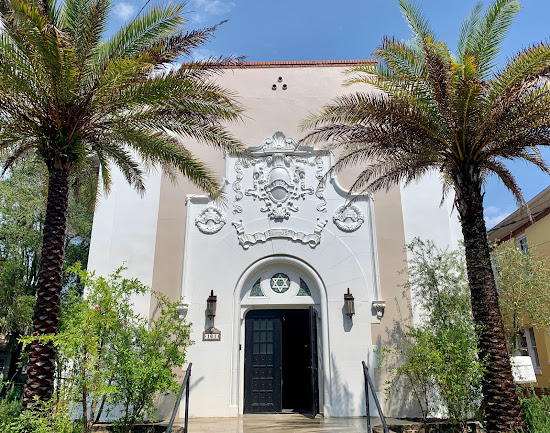First Congregation Sons of Israel
Saint Augustine, Florida
April 7, 2022
In the late 1800s, the congregation's first families came from Russia and Eastern Europe to settle in Saint Augustine. In 1908, the congregation was chartered with the State of Florida and religious services were held in members' homes until a Synagogue was constructed. Under the leadership of Rabbi Jacob Tarlinsky and his wife, the Synagogue was dedicated in 1923 with the completion and first service on March 30, 1924. The early Jewish congregants had the vision to provide a place for Jewish worship, learning, and activities for the members then, and to provide an enduring legacy for future generations.
Official Website: https://www.firstcongregationsonsofisrael.com/
Artifact 1
Pictured above is a Torah Ark inside of the Synagogue. The ark is located behind the Bimah, which is where the rabbi stands while conducting religious ceremonies. In older times when Jewish communities worshiped in their houses, the arks were built on wheels and moved before and after the ceremony. The ark inside of the Congregation Sons of Israel, although, is permanently placed in the center of the Synagogue. Inside of the ark is where the Torahs are kept. The Torah is the completion of the first five books of the Hebrew Bible. This ark holds original scripts which were brought down from Europe by the original founders of this Synagogue.
Artifact 2
The Lorillard Villa was located at 73 St. George Street, Jacob and Dora Tarlinsky purchased the home and its furniture in 1899. They raised their three daughters there. After Dora's death in 1937, the home was occupied by their oldest daughter Lena Tarlinsky Lichter, her husband Benjamin, and their children. In 1960, the home was demolished. The furniture shown above was located in the front parlor of the massive house. It was passed down to family members and has been donated to the Congregation Sons of Israel.
Exterior 1
Exterior 2
Above is a Hindu prayer alter, which has similar features to the ark found in the Synagogue. I am vaguely familiar with the Hindu religion and this type of prayer altar because my uncle grew up in India. As a young girl, I would watch as his mother sat inside the library room at their house and would pray behind her homemade alter similar to above. The Hindu altar and the ark use similar religious symbols and features that make these places sacred. They both contain light through candles which symbolize God and the light of God or Christ. Both also use symbols of the region's core, through the Hindu shrine displaying Ganesha and the Ark displaying the Star of David.
In Conversation Image 2
The photo above bears a resemblance to the First Congregation Sons of Isreal because of its beautiful stained glass. This is a picture of the Notre Dame Basilica of Montreal. Located in the historic district of Old Montreal in Montreal, Quebec, Canada, the basilica is Montreal's oldest Catholic Church known for its stained glass which tells a story of the city's history. Similarly, the stained glass inside the Synagogue tells a story of the Jewish people of Saint Augustine and also of the city. The stained glass in the Synagogue was replaced representing its normal form after damage due to a hurricane. The story of the stained glass restoration shows viewers what the place has gone through and how the community worked together in order to repair it. The glass itself also tells a story because it was replicated and redesigned to show Jewish symbols and symbols of the congregation as a whole.
In Conversation Passage ENG 202
The poem "Thirteen Ways of Looking at a Blackbird" by Wallace Stevens, consists of thirteen short, separate sections, each of which mentions blackbirds in some way. The poem uses and focuses on the words "to be" in seven out of the thirteen different variations of the blackbird. The blackbird is pictured in a different situation and articulated in a different grammatical way in each fragment of the poem. This mere idea of taking one idea and looking at it in many different ways encapsulates the entire idea of preservation as seen in the First Congregation Sons of Israel Synagogue. The synagogue used different types of preservation to keep the importance of the space after a devastating hurricane. People of the synagogue took action in order to save the place's legacy by renewing what was there before. For example, they reupholstered the old chairs after water damage and made them new while keeping some of the historic aspects of them. This demonstrates looking at something in different ways in order to problem solve and preserve what can be kept in order to make it new. The entire building had to be looked at in different aspects and the rebuilders could not dwell on the way the old building looked. They were forced to be creative and considered all aspects of renovation, looking at the new building with multiple lenses.
Creative Component
The infographic above was drawn with colored pencils and markers. I decided to make an informative poster of common symbols in Judaism because symbols are ways to tell stories and share information through visuals. I did not know much about the Jewish religion and after visiting the synagogue, I wanted to know more. I thought that an important first step to learning about religion is looking at the visuals that are commonly associated with it and searching for their meaning.










No comments:
Post a Comment